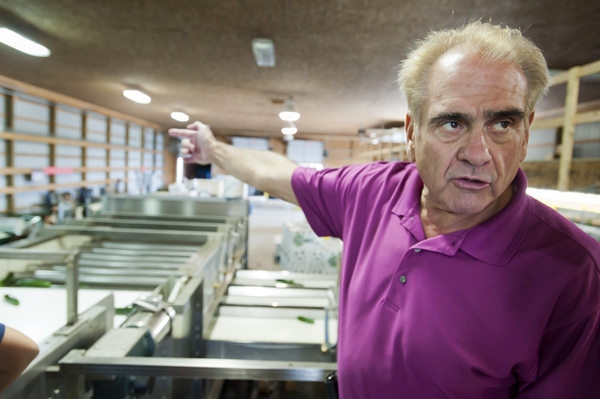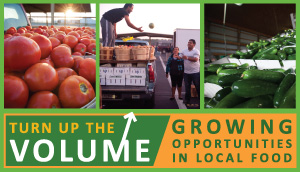TURN UP THE VOLUME: Growing opportunities in local food
Author: Patty Cantrell and Bob Heuer, Fair Food Network
Cracks in produce supply chains signal local food potential
Joe Pirrone knows what’s driving growth for his packing and shipping business.
Mike Pirrone Produce — named after Joe’s father, who started the business — markets vegetables, such as tomatoes, cucumbers, and peppers, from 55 nearby farms, including Pirrone’s own 1,300-acre operation. The company is expanding its southeast Michigan plant to capitalize on what Pirrone says is “tremendous opportunity” in the market for fresh and local.
“We have 1,500 bushels on a semi going to one distribution center that will service 150 stores,” he explains. “To truck that in from California, it’s $7,000. From here to our customer in Ohio, it’s $900.”

Joe Pirrone says "freight and freshness" are reasons his sales to nearby retail chains are growing. These factors plus additional "buy local" demand are opening opportunities for more farms to get into the wholesale supply chain.
In addition to the advantage of “freight and freshness,” Michigan growers have gained a marketing edge with retail chains that promote their products as “local.” Consumers do not know that retailers have always sourced from Michigan as buyers followed the harvest from southern to northern states.
It’s not a gimmick in Pirrone’s mind. “We are the local product,” he says.
While retailers may simply be sourcing more produce from established local suppliers, those growers and packers are adding capacity to fulfill growing demand. At the same time, America’s ever-adaptive produce delivery system is coming to grips with a local food movement that may have more traction than meets the eye.
Demand for direct-market, farmers’ market-type product is spilling over into higher volume wholesale channels. Industry players are responding not only with advertising but with attempts to shorten the distance between the farm gate and dinner plate, and provide more information about where the food comes from and who produced it. Consumers want evidence that their purchases are benefitting the local economy, increasing regional food security, and improving public health.
Shorter supply chains are just in the formative stage. But they have the potential to spur opportunity for growers who have survived market consolidation by expanding their operations as well as for newcomers starting in direct markets and expanding to wholesale.

Local demand is pulling more farms and products into larger-scale wholesale channels.
For retailers, the time and expense of cobbling together supply from a larger number of small farmers can be exasperating. Michigan Grocers Association vice president Mike Hamelin says some retailers quietly hope “local isn’t a trend, but a fad that has peaked.”
The opposite may be true, says Mike DiBernardo, economic development specialist with the Michigan Department of Agriculture & Rural Development. He contends supply chain innovations aren’t happening fast enough to satisfy demand for local and specialty products.
“It’s a real challenge,” he says, “to pull together the high quality, reliable supply the market demands. “But that also leaves aggregators some opportunities.”
One is the institutional food market.
Earlier this year, 78 Michigan hospitals — half of the hospitals statewide — pledged to obtain 20 percent of their food from local sources by 2020.
Pressure on distributors to supply this demand comes from people like Christa Byrd, food service manager for Lansing, MI-based Sparrow Hospital. Its annual food budget exceeds $3 million.
“We have purchasing power,” she explains. “And we have a responsibility, a mission, to improve health and well-being in the community. Buying local is a way to start working on that, by supporting farmers and our local economy.”
“Part of this local food business is the sustainability of farms,” says Suttons Bay, MI, grower Jim Bardenhagen, who now sells potatoes to four school districts in northern Michigan. He started off in 2004 with taste tests at one Traverse City elementary school. Since that time, Michigan has gone from zero to 60 formal farm-to-school procurement programs. Nationally the number has grown to an estimated 2,400 with nearly 10,000 schools involved.
In 2007, the Chicago Public Schools spent $10,000 a year on Midwest produce. This year, it’s up to $1 million in “local” produce, or one-third of the district’s total produce spending, says Jean Saunders, marketing director for Chartwells-Thompson Hospitality, which operates the district’s food service.
Much of it comes from Michigan, the next-door state with a great range of fruits and vegetables. Don Armock of Sparta in west Michigan is one of the suppliers. He runs a fruit farm that’s been in his family since the 1840s. He also operates Riverridge Produce Marketing Inc., a brokerage that supplies more than a third of Michigan’s fresh market apples to supermarkets, airlines and food service companies.
“Chicago Public Schools are buying our medium-sized fruit,” Armock says. “We can get apples out of the orchard or out of storage and have them in school cafeterias in one or two days. All those health and freshness benefits accrue to the students.”
Cesar Davolina, president of Christina Foods, a Chicago-based trucking and warehousing company that serves Chicago schools, has begun actively working to ramp up a supply network of farmers and farm-related businesses in a 300-mile radius.
“This is a fundamental shift in how Cristina Foods expects to grow,” he says.
Greenstone Farm Credit Services president Dave Armstrong cites numerous ways that small and mid-size producers, as well as larger operations, are seizing opportunities in local and specialty products. The question on his mind and many others is how far local can go.
“Is it enough to dramatically change how agricultural products are grown and marketed? Maybe not yet,” Armstrong said, “but we’re starting to see gradual changes in that direction.”
Photos copyright Gary L. Howe.

Turn up the Volume is a Fair Food Network project to investigate local food market potential for Michigan growers, processors, and distributors. Patty Cantrell, Regional Food Solutions LLC, produces the series for the Fair Food Network with USDA Specialty Crop Block Grant support. See the full series on Facebook.







